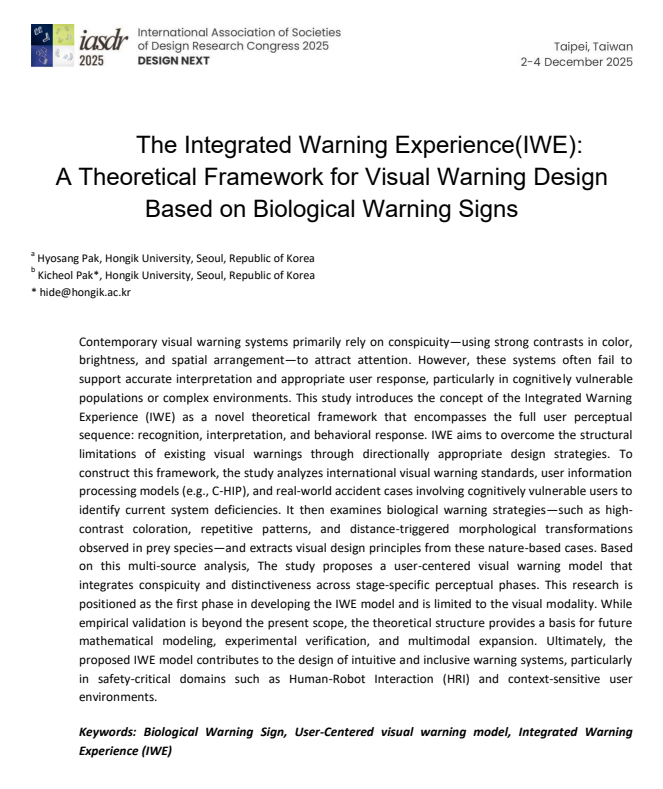통합 검색
통합 검색
- 작성자 HIDE
- 조회수 44

Topic: The Integrated Warning Experience(IWE) A Theoretical Framework for Visual Warning Design Based on Biological Warning Signs
This study proposes the Integrated Warning Experience (IWE) as a new theoretical framework for visual warning design inspired by biological warning signs. Conventional warning systems emphasize conspicuity—using high chromatic contrast, brightness, and geometric shapes to attract attention. However, such approaches often fail to support accurate interpretation and appropriate behavioral responses, especially among vulnerable populations such as the elderly, individuals with low literacy, or people with hearing impairments.
Through analysis of international standards (ISO, ANSI, KS, JIS), the Communication–Human Information Processing (C-HIP) model, and real-world accident cases, the study identifies structural deficiencies in current systems. It emphasizes that warnings must not only be noticeable but also distinctive, enabling users to interpret signals correctly and take timely action. To address these limitations, the study examines biological strategies—such as aposematism in poison dart frogs, sudden inflation in pufferfish, or contextual pattern displays in octopuses—that instinctively trigger predator avoidance. These strategies provide design principles including color and brightness contrast, repetitive patterns, morphological transformation, mimicry, and distance-dependent signaling.
Case analyses demonstrate that auditory-centered warnings often fail in industrial and disaster contexts, placing hearing-impaired or low-literacy users at severe risk. This underscores the need for visually grounded, user-centered systems. By comparing the Predation Sequence with the C-HIP model, the study re-structures the warning process into six integrated stages: Encounter (source), Detection (attention), Identification (comprehension), Approach/Avoidance (motivation), Avoidance Action (behavior), and Feedback (learning).
Based on these insights, the IWE model is proposed. At long distances, high chroma and luminance contrast with simple edges facilitate rapid detection. At close range, shifts in color or pattern intensity support interpretation and guide specific user responses. Once the threat is resolved, visual feedback indicates state transition, ensuring cognitive closure and reassurance.
The theoretical contributions are fourfold. First, the study introduces distinctiveness as a complementary dimension to conspicuity, strengthening user interpretation and response. Second, it provides a biologically grounded framework for distance- and stage-specific warning design. Third, it incorporates environmental contrast and feedback mechanisms, addressing gaps in conventional models. Fourth, it highlights the challenges faced by cognitively vulnerable groups and suggests inclusive applications for safety-critical domains such as Human–Robot Interaction (HRI) and industrial settings.
The study is limited by its theoretical nature, lacking experimental validation. Future research should empirically test the effectiveness of biologically inspired strategies through behavioral experiments, eye-tracking in context-rich environments, and toolkits for automated warning design. Moreover, multimodal expansion to auditory, tactile, and motion-based cues is necessary to establish comprehensive, integrated warning systems.
In conclusion, this research reconceptualizes warnings as an experience that encompasses recognition, interpretation, and action, rather than mere attention capture. By integrating conspicuity with distinctiveness, the IWE framework lays a foundation for intuitive, inclusive, and context-sensitive warning systems that can enhance safety in complex environments.
본 연구는 기존 시각적 경고 체계의 한계를 극복하기 위해 자연계의 생물학적 경고 신호를 기반으로 한 새로운 이론적 틀, 즉 통합 경고 경험(Integrated Warning Experience, IWE)을 제안한다. 현재의 경고 시스템은 주로 강렬한 색상 대비나 단순한 기하학적 형상을 활용하여 눈에 잘 띄게 만드는 ‘현저성(conspicuity)’에 집중하고 있다. 그러나 이러한 방식은 실제 사용자들이 경고를 인식한 이후 올바른 해석과 행동으로 이어지도록 지원하는 데에는 미흡하며, 특히 노년층, 문해력이 낮은 집단, 청각 장애인 등 인지적 취약 계층에게는 효과가 제한적이다.
연구는 국제 표준(ISO, ANSI, KS, JIS 등), 인지 처리 모델(C-HIP), 그리고 실제 사고 사례를 분석하여 현재 경고 체계의 구조적 문제점을 도출하였다. 그 결과, 경고가 잘 보이는 것만으로는 충분하지 않고, 사용자가 이를 해석하고 적절히 행동할 수 있도록 돕는 ‘변별성(distinctiveness)’ 개념을 보완해야 함을 강조한다. 또한, 자연계의 경고 표현—예컨대 독개구리의 선명한 체색, 복어의 체적 확장, 문어의 위협적 패턴 노출 등—은 포식자의 본능적 회피 반응을 유도하는 효과적 전략임을 확인하였다. 이를 토대로 연구는 생물학적 원리를 경고 디자인 요소로 추출하여, 색 대비, 명도 대비, 반복적 패턴, 형태 변환, 거리 의존적 신호 등 구체적인 설계 지침을 도출하였다.
사례 분석에서는 실제 산업 현장 및 재난 상황에서 청각 중심 경고가 무력화되어 발생한 사고들을 검토하였다. 청각장애인이나 저문해 사용자들이 시각적 대체 신호 부재로 인해 대피가 지연되거나 경고를 잘못 해석하는 문제는 기존 시스템의 구조적 한계를 명확히 보여준다. 이를 보완하기 위해 연구는 포식-피식 모델(Prey–Predator Sequence)과 C-HIP 모델을 통합하여 새로운 단계적 경고 구조를 제시하였다. 즉, (1) 조우(Encounter)–주의 전환, (2) 탐지–주의 유지, (3) 식별–의미 해석, (4) 접근/회피–동기 형성, (5) 회피 행동–행동 실행, (6) 피드백–학습으로 이어지는 과정 속에서 시각적 설계 요소가 거리와 상황에 맞게 배치되어야 한다는 것이다.
이러한 논의를 바탕으로 연구는 IWE 모델을 제안한다. IWE는 멀리서 인지되는 단계에서는 고채도·고명도 대비와 단순한 형상을 사용하여 빠른 탐지를 유도하고, 가까운 거리에서는 패턴 변화나 색상 전환을 통해 의미 구분과 행동 지침을 제공한다. 또한 위험이 해소된 뒤에는 시각적 피드백을 제공하여 사용자가 상황 전환을 인지하고 인지적 종결(cognitive closure)을 경험하도록 한다.
연구의 주요 공헌점은 네 가지다. 첫째, 단순히 잘 보이게 하는 데 그치지 않고 ‘변별성’을 도입함으로써 사용자의 해석과 반응을 강화하였다. 둘째, 생물학적 사례에 기반한 거리별·단계별 경고 설계 틀을 마련하였다. 셋째, 배경 대비와 피드백 메커니즘을 포함하여 기존 경고 모델의 미비점을 보완하였다. 넷째, 청각 장애인이나 저문해 집단 등 취약 계층을 고려한 포괄적 설계 방향을 제시하였다.
다만 본 연구는 이론적 탐구에 머물러 있으며, 실제 사용자 실험이나 정량적 검증은 수행하지 못했다는 한계가 있다. 따라서 향후 연구에서는 색 대비와 패턴 효과의 행동적 실험 검증, 시선 추적 기반의 실시간 효과 측정, 자동화된 경고 디자인 툴킷 개발, 시각에 국한되지 않은 청각·촉각·모션을 포함한 다중감각 통합 경고 시스템으로의 확장이 필요하다.
결론적으로, 본 연구는 경고 디자인을 단순한 시각적 주목의 차원을 넘어, 인지–해석–행동의 전 과정을 포괄하는 경험으로 정의하고 이를 체계화하였다. IWE는 인간-로봇 상호작용(HRI)이나 복잡한 산업 환경과 같이 안전성이 중대한 맥락에서 직관적이고 포용적인 경고 체계를 구축하는 새로운 이론적 토대를 제공한다.

댓글 0